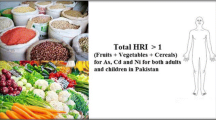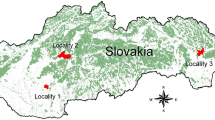Abstract
The occurrence of 210Pb, 210Po, trace elements was assessed in a selection of berries on commercial sale in Italy. Data confirmed that berries might serve as an important source of essential elements. The 210Pb, 210Po concentrations found were higher than the reference values reported by UNSCEAR for roots and fruits in the world. There is no risk whatsoever from the intake of toxic elements as Al, As, Cd, Pb, Ni, Hg in berriberries analyzed; it is necessary, however, continuously monitored the levels of these elements to protect consumers against potential adverse health effects especially when consumed in large quantities.
Similar content being viewed by others
References
Vaaramaa K, Solatie D, Aro L (2009) Distribution of 210Pb and 210Po concentrations in wild berries and mushrooms in boreal forest ecosystem. Sci Total Environ 408:84–91
Parfenov Y (1974) Polonium-210 in the environment and in the human organism. At Energy Rev 12:75–143
Brown JE, Gjelsvik R, Ross P, Kalas JA, Outola I, Holm E (2011) Levels and transfer of 210Po and 210Pb in Nordic terrestrial ecosystem. J Environ Radiat 102:430–437
Persson B, Holm E (2011) Polonium-210 and lead-210 in the terrestrial environment, a historical review. J Environ Radioact 102:420–429
United Nations Scientific Committee on the Effects of Atomic Radiation (UNSCEAR) (1988) Sources and effects of ionizing radiation. Report to the General Assembly, with Annexes
ATSDR. US department of health and human services, Agency for toxic substances and disease registry, Toxicological profile for lead. Draft for Public Comment, May 2019
De Almeida Lopes AC, Navas-Acien A, Zamoiski R, Silbergeld EK, Carvalho M, Buzzo ML, Ragassi Urbano M, da Cunha Martins A, Bastos Paoliello MM (2015) Risk factors for lead exposure in adult population in Southern Brazil. J Toxicol Environ Health A 78:92–108
Rodushkin I, Odman F, Holmstrom H (1999) Multi-element analysis of wild berries from northern Sweden by ICP techniques. Sci Total Environ 231:53–65
Meli MA, Desideri D, Roselli C, Benedetti C, Feduzi L (2015) Essential and toxic elements in honeys from a region of Central Italy. J Toxicol Environ Health A 78:617–627
Desideri D, Cantaluppi C, Ceccotto F, Meli MA, Roselli C, Feduzi L (2016) Essential and toxic elements in seaweeds for human consumption. J Toxicol Environ Health A 79:112–122
WHO Fruit and Vegetable Promotion Initiative – report of the meeting, Geneva, 25–27 August 2003
De Quadros APO, Mazzeo DEC, Marin-Morales MA, Perazzo FF, Rosa PCP, Maistro EL (2017) Fruit extract of the medicinal plant Crataegus oxyacanthaexerts genotoxic and mutagenic effects in cultured cells. J Toxicol Environ Health A 80:161–170
Seeram NP (2010) Recent trends and advances in berry health benefits research. J Agric Food Chem 58:3869–3870
Mazzoni L, Perez-Lopez P, Giampieri F, Alvarez-Suarez JM, Gasparrini M, Forbes-Hernandez TY, Quiles JL, Mezzetti B, Battino M (2016) The genetic aspects of berries: from field to health. J Sci Food Agric 96(2):365–371
Skrovankova S, Sumczynski D, Mlcek J, Jurikova T, Sochor J (2015) Bioactive compounds and antioxidant activity in different types of berries. Int J Mol Sci 16(10):24673–24706
Vendrame S, Del Bo C, Ciappellano S, Riso P, Klimis-Zacas D (2016) Berry fruit consumption and metabolic syndrome. Antioxidants 5:34–55
Girgenti V, Massaglia S, Mosso A, Peano C, Brun F (2016) Exploring perception of raspberry and blueberries by Italian consumers. Sustainability 8:1027–1043
Gwynn JP, Nalbandyan A, Rudolfsen G (2013) 210Po, 210Pb, 40K and 137Cs in edible wild berries and mushrooms and ingestion doses to man from high consumption rates of these wild foods. J Environ Radiat 116:34–41
McDonald P, Jackson D, Leonard DRP, McKay K (1999) An assessment of 210Pb and 210Po terrestrial foodstuffs from regions of potential technological enhancement in England and Wales. J Environ Radioact 43:15–29
Ryan B, Martin P, Iles M (2005) Uranium series radionuclides in native fruits and vegetables of northern Australia. J Radioanal Nucl Chem 264(2):407–412
Solatie D, Junttila M, Vesterbacka P (2006) 210Po and 210Pb in the food chain lichen-reinder-human. Radiochemistry 48(6):632–633
United States Environmental Protection Agency (US EPA) (1996) Method 3050B: acid digestion of sediments, sludges and soils. Revision 2, December 1996
Meli MA, Fagiolino I, Desideri D, Roselli M (2018) Essential and toxic elements in honeys consumed in Italy. J Toxicol Environ Health A 81:1123
United States Environmental Protection Agency (US EPA) (2014) Method 6020B (SW-846): inductively coupled-mass spectrometry, Revision 2
United States Environmental Protection Agency (US EPA) (2014) Method 6010D (SW-846): inductively coupled plasma-optical emission spectrometry, Revision 4
United States Environmental Protection Agency (US EPA) (1994) Method 7470A (SW-846): mercury in liquid waste (Manual Cold-Vapor Technique), Revision 1
Desideri D, Roselli C, Fagiolino I, Meli MA (2018) Toxic elements in human saliva of smokeless tobacco users. J Anal Toxicol 42:417–424
Meli MA, Desideri D, Cantaluppi C, Ceccotto F, Feduzi L, Roselli C (2018) Elemental and radiological characterization of commercial Cetraria islandica (L.) Acharius pharmaceutical and food supplementation products. Sci Total Environ 613–614:1566–1572
International Atomic Energy Agency, IAEA (1996) International Basic Safety Standards for Protection against Ionizing radiation and for the Safety of Radiation Sources, safety Series No. 115, IAEA, Vienna
European of Safety Authority (EFSA) (2006) Scientific committee on food scientific panel on dietetic products, nutrition and allergies. Tolerable upper intake levels for vitamins and minerals, February 2006
JEFCA (2006) Summary and conclusions of the sixty-seventh meeting of the Joint FAO/WHO Expert Committee on Food Additives, Rome, 20–29 June 2006
WHO (2011) Evaluation of Certain food additives and contaminants. Seventy-second report of the Joint FAO/WHO Expert Committee on Food Additives, WHO Technical Report Series No. 959 Geneva, Switzerland
WHO (2011) Evaluation of certain food additives and contaminants. Seventy-third Report of the Joint FAO/WHO Expert Committee on Food Additives, Geneva 2010. WHO Technical Report Series No. 960 Geneva, Switzerland
Meli MA, Desideri D, Roselli C, Feduzi L (2014) Assessment of 210Po in Italian diet. Food Chem 155:87–90
Green N, Hammod DJ, Davidson MF, Wilkins BT, Williams B (2002) The radiological impact of naturally occurring radionuclides in foods from the wild. NRPB-W30. National Radiological Protection Board, Didcot
Istituto Nazionale di Ricerca per gli Alimenti e la Nutrizione ( INRAN) (2013). Carnovale E and Marletta L, Banca Dati di Composizione degli Alimenti
Varo P, Lahelma O, Nuurtamo M, Saari E, Koiviststoinen P (1980) Mineral element composition of Finnish foods. Potato, vegetables, fruits, berries, nuts and mushrooms. Acta Agric Scand 22:89–113
Barcan VSH, Kovnatsky EF, Smetannikova MS (1998) Absorption of heavy metals in wild berries and edible mushrooms in an area affected by smelter emissions. Water Air Soil Pollut 103(1-4):173–195
Moilanen M, Fritze H, Nieminen M, Piirainen S, Issakainen J, Piispanen J (2006) Does wood ash application increase heavy metal accumulation in forest berries and mushrooms? For Ecol Manag 226:153–160
Euromonitor International (2017) Global consumer trends survey. London 2017
United Nations Scientific Committee on the Effects of Atomic Radiation, Ionizing (UNSCEAR) (2000). Sources and effects of ionizing radiation., New York. Report to the General Assembly with Annex, 2000
United Nations Scientific Committee on the Effects of Atomic Radiation (UNSCEAR) (2008) Sources and effects of ionizing radiation. New York: United Nations (published 2010)
European Commission (EC) (2006) Commission Regulation No 1881/2006 of 19 December 2006 setting maximum levels for certain contaminants in foodstuffs
Acknowledgements
The authors wish to express their deep gratitude to Dr. Marco Rocchi for his contribute to statistical analysis.
Funding
Funding was provided by Università degli Studi di Urbino Carlo Bo (Grant No. 103),
Author information
Authors and Affiliations
Corresponding author
Additional information
Publisher's Note
Springer Nature remains neutral with regard to jurisdictional claims in published maps and institutional affiliations.
Rights and permissions
About this article
Cite this article
Meli, M.A., Desideri, D., Fagiolino, I. et al. Trace elements, 210Po and 210Pb in a selection of berries on commercial sale in Italy. J Radioanal Nucl Chem 321, 647–657 (2019). https://doi.org/10.1007/s10967-019-06604-8
Received:
Published:
Issue Date:
DOI: https://doi.org/10.1007/s10967-019-06604-8




